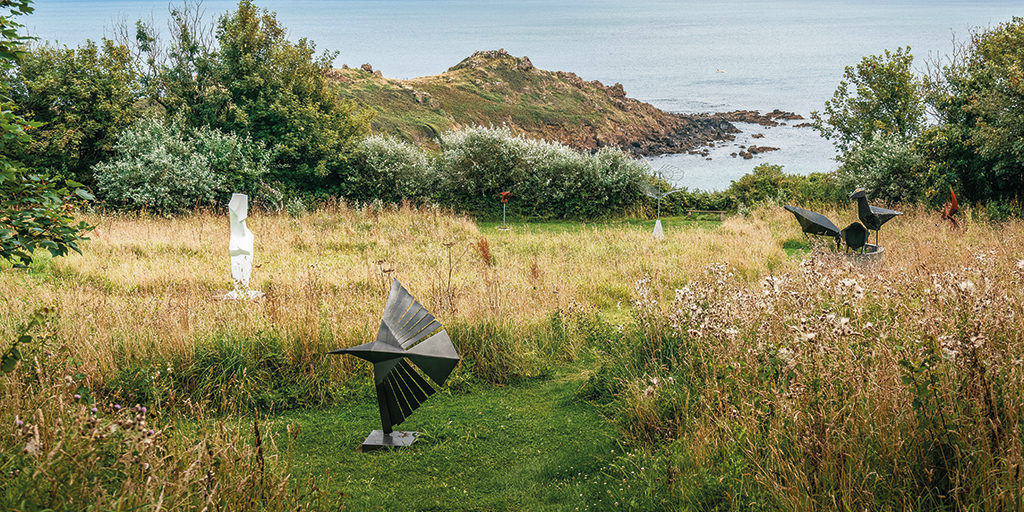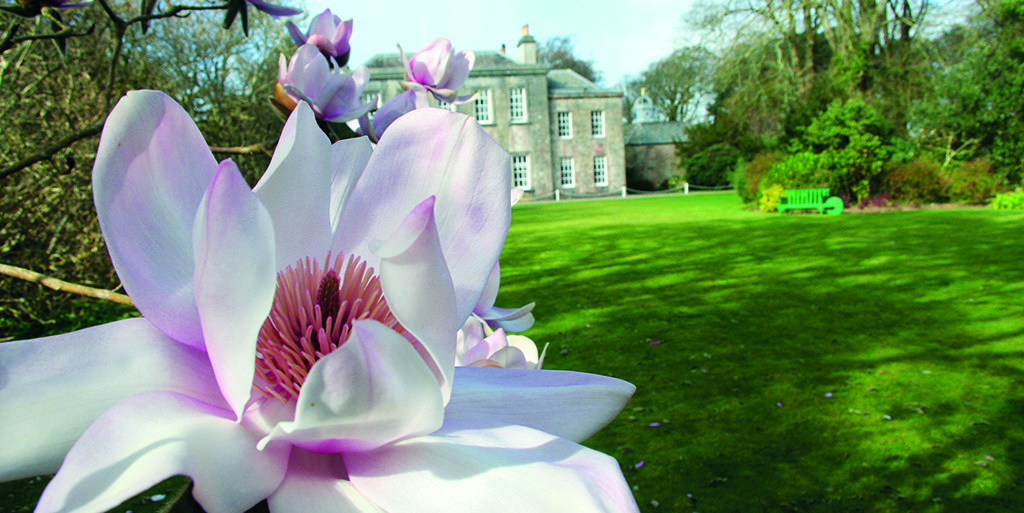

A county in colour
Immerse yourself in Cornwall’s gardens as they begin their annual spring bloom.
Well, what a windswept winter it’s been! I’m sure that we at Cornwall Living aren’t the only ones who are glad to start seeing the back of the cold season, not least because it was the stormiest on record since 2015. With spring upon us, Cornwall is finally starting to come back to life; the hedgerows are bursting into colourful life and our days are once more beginning with the dawn chorus of birds as they too celebrate the seasonal change. For a microcosm of everything that makes Cornwall such a wonderful place to be in the spring, any one of the county’s beautiful gardens is well worth a visit. Each with something different to offer visitors, with the common purpose of celebrating the beautiful worlds of botany, horticulture and landscape, those featured across the following pages are just a snapshot of Cornwall’s many public gardens.
Cornwall Garden Society
Before we delve into the many sites open for visitors this season, we feel that no exploration of Cornish gardens would be complete without a mention of the Cornwall Garden Society (CGS). A charity that exists to encourage and improve the science, art and practice of horticulture in all its branches, CGS works to share knowledge about gardening, celebrate Cornwall’s rich garden heritage and conserve its natural environment. Although it has, by this time, already taken place, each spring sees CGS run the annual Spring Flower Show. Taking place at The Royal Cornwall Showground, visitors flock to enjoy dramatic displays of spring flowers and shrubs, along with exquisite exhibits by leading nurseries and floral designers. Described by The Telegraph as “the most highly regarded spring show in the country”, it’s a must-attend event for any gardening enthusiast, and certainly one to add to your diary for next year!
www.cornwallgardensociety.org.uk
The Lost Gardens of Heligan
We begin our whistle-stop tour of Cornwall’s gardens with those that were once lost. These previously well-kept gardens quickly succumbed to the forces of nature as those who tended it left to fulfil their duty in the national First World War effort. Disappearing beneath hectares of heath and bramble, it wasn’t until 1990 that Sir Tim Smit and John Willis rediscovered the derelict gardens and set about enacting their restoration. Restored under the careful guidance of the duo, with Tim Smit also famed for leading the development of the Eden Project, Heligan now provides visitors with a cornucopia of horticultural explorations to engage and excite the whole family. With pleasure grounds to explore, some of Britain’s finest productive gardens, as well as the UK’s only outdoor jungle, The Lost Gardens of Heligan transport visitors far from the shores of Cornwall, to a world of romance, nostalgia and adventure.
Trewithen Gardens
Meaning “house of the trees”, Trewithen is home to 30 acres of woodland gardens and more than 200 acres of parkland. With so many different areas and species to discover, it’s a place that intrigues and enchants at every turn, one where no two days are the same and one in which the seasons play a key part. In the spring, expect exotic bursts of colour, with whites, reds, yellows and almost every shade of pink, before witnessing the summer bloom of hydrangeas and roses. Explore the wildlife and water gardens; examine an array of sculpture and conceptual art, and admire the historic plantings that continue to thrive here. With all of this and more to explore outdoors, not to mention the historic house which dates back
to the Domesday survey of 1086 (open for tours Sunday to Tuesday, 28th April to 2nd July), and Trewithen offers visitors a heady cocktail of history and horticulture that’s sure to keep everybody enthralled.
Trebah Garden
Where else can you follow the meandering trails of a sub-tropical garden, arriving eventually at a private beach where coffee, ice creams and staggering river views are available in abundance? Originally planted as a pleasure garden by the Fox family in the 19th century, the sloping gardens of Trebah, winding their way through a valley on the edge of the Helford River, have lived through a tumultuous history. The site served as a staging area for American troops ahead of the Second World War Normandy invasion; after the war, it changed hands several times. Famed racing driver, Donald Healey, bought the site and removed much of the wartime concrete from the beach. It was later sold again to Major Tony Hibbert and Eira Hibbert, who were persuaded by Cornwall Garden Society to begin a programme of work that would restore the garden to its former glory and eventually enable its opening to the public.
Glendurgan Garden
This historic and exotic wooded valley also leads down to the river. The garden itself is a beautiful, distinctive and intriguing collection of specimens interspersed with wildflower meadows. On site there is also a cherry laurel maze, based on a design taken from the Sydney Gardens in Bath. The Giant’s Stride rope swing is a simple yet enjoyable way for families to spend time together, whilst Durgan beach on the banks of the Helford connects to the South West Coast Path, ideal for walkers looking to lace up their boots and strike out along the coast. Add to all of this the Apple Shed, full of nature-based activities, along with refreshments at the Tea House (currently undergoing renovations), and Glendurgan offers a day out for both families
and horticultural die-hards alike.
www.nationaltrust.org.uk/visit/cornwall/glendurgan-garden
Terence Coventry Sculpture Park
Follow the coast south and you’ll eventually come to Coverack, one of the Lizard Peninsula’s most popular seaside villages. From here, head just a short distance inland and you’ll find the Terence Coventry Sculpture Park. Situated within three small meadows astride the old coast path, visitors can usually find around 25 monumental sculptures on display. With access to the park free of charge, it provides a wonderful chance to examine the work of Terence Coventry; rooted in a strong, figurative tradition, Coventry explores forms that are familiar to him, expressing his fundamental relationship with his environment and producing images that are at once enormously powerful and tender.
Tremenheere Sculpture Gardens
If the work of Terence Coventry has whet your appetite for enjoying art al fresco, then be sure to make your next stop Tremenheere Sculpture Gardens. Overlooking St Michael’s Mount at the start of the Penwith Peninsula, this dramatic landscape comprises exotic and sub-tropical planting and provides a backdrop to contemplative and inspiring art by artists of international renown. With woods and a stream, an ever-evolving programme of contemporary artwork on display, not to mention an indoor gallery, shop, nursery, restaurant, and those aforementioned views over Mount’s Bay and the castle it’s named after, and this really is a must-visit for anyone looking to explore Cornwall’s best gardens.
Trewidden House & Garden
This Grade II listed manor house with beautiful accommodation finds itself immersed in 15 acres of gorgeous Cornish spring gardens near Penzance. As a place to stay, it’s tough to beat, especially for those hoping to base themselves in prime position to explore all that Penwith has to offer. As a garden, it’s simply magnificent. Originally planted in the 19th century by Thomas Bolitho, it incorporates a magnificent collection of more than 300 camellias and magnolias, alongside one of the largest tree fern dells in Europe. A maze of paths take visitors to different areas of the site, adorned with shrubs and champion trees, some of which are more than a century old. Kids also love it here, especially when they take the Trewidden Trail, and the whole family is sure to appreciate the tea rooms, offering light lunches and Cornish cream teas, with produce of local provenance appearing on every plate.
Tresco Abbey Garden
We end our tour not on the mainland, but on the Isles of Scilly. Just a short hop from the Cornish coast, visitors to this archipelago are awed by its feeling of far-away shores. The fine golden sand and crystalline waters are an attraction in themselves and, depending on who you talk to, everybody who visits has a different favourite isle. In this case, our focus is on Tresco, and what has to be the jewel in the Isles of Scilly’s crown: Tresco Abbey Garden. Hailed as a “perennial Kew without the glass”, the garden is home to some 2,000 specimens from across the southern hemisphere and subtropics, and all of them flourish just 28 miles off the Cornish coast. The gardens change throughout the year; flowers bloom weeks ahead of the mainland in spring, the perfect tonic after a long, dreary winter, and in autumn, the seasonal reds, golds and ambers contrast magnificently with proteas, aloes and camellias. Even at the winter solstice, you’ll still find around 300 species in beautiful bloom. Add to its floral charm the sight of red squirrels and golden pheasants, not to mention the chance to browse island shipwrecks in the Valhalla Figurehead Museum, and whether you’re visiting Scilly for the day (which you can), or staying for a few, Tresco Abbey Garden is an essential addition to any island itinerary.










